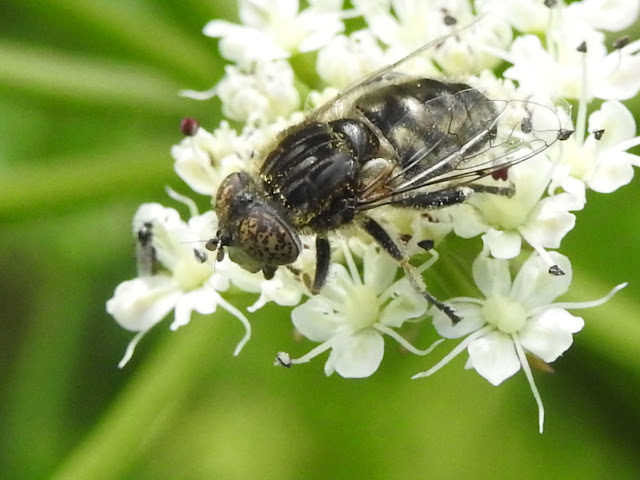It was a disappointing year with 51 species recorded, compared with 61 in 2021, although one species was new for the Recording Area. Presumably the poor year was due to the very dry conditions, these affected the life-cycle of certain species that develop in aquatic environments and wet rotting vegetation. Low numbers overall were recorded throughout the spring with nectaring adults also limited by flowering plants going over quickly and early.
The earliest were winter active Marmalade Hoverfly Episyrphus balteatus and Spotted Meliscaeva M. auricollis, both on 1 Jan, with the next species, Common Dronefly Eristalis tenax on 2 Feb. Although there were good numbers of this species in the spring, the summer generation was noticeably low. True spring hoverflies first emerged in late February with Hairy-eyed Syrphus S. torvus on 25th and Slender Melanostoma M. scalare on 27th.
Into March, with the weather warming up, more species emerged with Alexanders flowers and sallow blossom a main attraction. The first March hoverflies were Dull-bellied Blacklet Cheilosia proxima and Common Spotted Field Syrph Eupeodes luniger on 4th, followed by both Furry and Tapered Dronefly Eristalis intricaria & E. pertinax on 12th. Grey-spotted Boxer Platycheirus albimanus were gathering in numbers from 17th, preferring low growing flowers for nectar. An early Tiger Hoverfly Helophilus pendulus on 18th proved to be a false dawn as numbers were low this year, with some scarcer Heliophilus not recorded at all. As with droneflies, this group's larvae are aquatic.
During favourable weather, a Common Twist-tail Sphaerophoria scripta on the 23rd was probably the first migrant of the year. The sunny conditions also saw Meadow Field Syrph Eupeodes latifasciatus emerge on 24th, with Short Melanostoma M. mellinum and Platycheirus scutatus on the wing from 26th.
The overly fine weather continued into April with the first Humming Syrphus S. ribesii on 7th and Striped-backed Fleckwing Dasysyrphus albostriatus on 9th. Later in the moth Early Epistrophe E. eligans and Smudge-veined Clubtail Neoascia prodagria were seen on 21st, with the only new species for the Recording Area, found the next day. This was Common Snout Rhingia campestris, a common and widespread species whose appearance was expected and long overdue, it however remained the only record.
Into May and variety was reaching its peak, with new species emerging on a regular basis. The first Superb Ant-hill Hoverfly Xanthogramma pedissequum on 3rd, with Batman Hoverfly Myathropa florea, Rural Roundface Eumerus strigatus and Small Spotty-eyed Dronefly Eristalinus sepulchralis on 5th. A trio of Blacklets were found nectaring on umbellifers mid month, Burdock Blacklet Cheilosia impressa on 12th, Buttercup Blacklet C. albitarsis on 15th and Bumblebee Blacklet C. illustrata on 19th.
Preferring the flower meadows, Stripe-faced Dronefly Eristalis nemorum males could often be seen characteristically over feeding females from 19th, with Striped-winged Dronefly E. horticola and Gossamer Hoverfly Baccha elongata from 22nd.
The bumblebee mimic Narcissus Fly Merodon equestris, Pied Plumehorn Volucella pellucens and Pipizella viduata were first seen around their preferred bramble patches and woodland edges on 26th & 27th. May ended with several Migrant Field Syrph Eupeodes corollae on 28th.
A White-clubbed Glasswing Scaeva pyrastri on 8 Jun was a further sign of migrant activity. Typical summer hoverflies were represented by three different mimics, Bumblebee Plumehorn Volucella bombylans from 8th, Hornet Plumehorn V. zonaria from 10th and Wasp Plumehorn V. inanis on 11th. The latter two species seeking out wasp nests to lay eggs. The first Golden-tailed Leaf Licker Xylota sylvarum was feeding on aphid honeydew and pollen on 16th, the tiny Common Paragus P. haemorrhous could be found nectaring on their preferred hawkbits and dandelions from 22nd, with Broad-banded Epistrophe E. grossulariae active on Hogweed from 25th.
In July Bolete Blacklet Cheilosia scutellata on 16th and Dark-winged Chrysogaster C. solstitialis from 29th, joined other hoverfly species on the few remaining umbellifers in flower. Into August activity switched to the flower meadows with species nectaring on Water Mint and Ragwort. A presumed migrant Large Tiger Hoverfly Helophilus trivittatus was seen on 7th, with Glass-winged Syrphus S. vitripennis from 11th and the wasp mimic Hook-barred Spearhorn Chrysotoxum festivum on 26th.
Back to the wood and scrub edges in September with Plain-faced Dronefly Eristalis arbustorum from 3rd, Pale-knobbed Lucent Didea fasciata from 9th, Yellow-barred Peat Hoverfly Sericomyia silentis on 20th and Yellow-girdled Fleckwing Dasysyrphus tricinctus on 24th, continued the recent run of autumn occurrences for these heathland species.
On warmer days in October some species were on the wing with Marmalade and Tiger Hoverfly, Humming Syrphus, Common Spotted Field Syrph and Slender Melanostoma on 13th. Into November late flying individuals could still be found on Ivy with Marmalade Hoverfly on 12th, Humming Syrphus on 17th and a Slender Melanostoma on 30th.











No comments:
Post a Comment